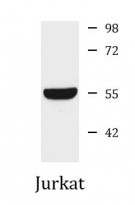ARG57334
anti-BPI antibody
anti-BPI antibody for Western blot and Human,Mouse
Overview
| Product Description | Rabbit Polyclonal antibody recognizes BPI |
|---|---|
| Tested Reactivity | Hu, Ms |
| Tested Application | WB |
| Host | Rabbit |
| Clonality | Polyclonal |
| Isotype | IgG |
| Target Name | BPI |
| Antigen Species | Human |
| Immunogen | Recombinant Protein of Human BPI. |
| Conjugation | Un-conjugated |
| Alternate Names | BPI; rBPI; BPIFD1; CAP 57; Bactericidal permeability-increasing protein |
Application Instructions
| Application Suggestion |
|
||||
|---|---|---|---|---|---|
| Application Note | * The dilutions indicate recommended starting dilutions and the optimal dilutions or concentrations should be determined by the scientist. | ||||
| Positive Control | Jurkat |
Properties
| Form | Liquid |
|---|---|
| Purification | Affinity purification with immunogen. |
| Buffer | PBS (pH 7.3), 0.02% Sodium azide and 50% Glycerol. |
| Preservative | 0.02% Sodium azide |
| Stabilizer | 50% Glycerol |
| Storage Instruction | For continuous use, store undiluted antibody at 2-8°C for up to a week. For long-term storage, aliquot and store at -20°C. Storage in frost free freezers is not recommended. Avoid repeated freeze/thaw cycles. Suggest spin the vial prior to opening. The antibody solution should be gently mixed before use. |
| Note | For laboratory research only, not for drug, diagnostic or other use. |
Bioinformation
| Database Links |
Swiss-port # P17213 Human Bactericidal permeability-increasing protein Swiss-port # Q67E05 Mouse Bactericidal permeability-increasing protein |
|---|---|
| Gene Symbol | BPI |
| Gene Full Name | bactericidal/permeability-increasing protein |
| Background | This gene encodes a lipopolysaccharide binding protein. It is associated with human neutrophil granules and has antimicrobial activity against gram-negative organisms. [provided by RefSeq, Nov 2014] |
| Function | The cytotoxic action of BPI is limited to many species of Gram-negative bacteria; this specificity may be explained by a strong affinity of the very basic N-terminal half for the negatively charged lipopolysaccharides that are unique to the Gram-negative bacterial outer envelope. Has antibacterial activity against the Gram-nagative bacterium P.aeruginosa, this activity is inhibited by LPS from P.aeruginosa. [UniProt] |
| Calculated MW | 54 kDa |
Images (1) Click the Picture to Zoom In






